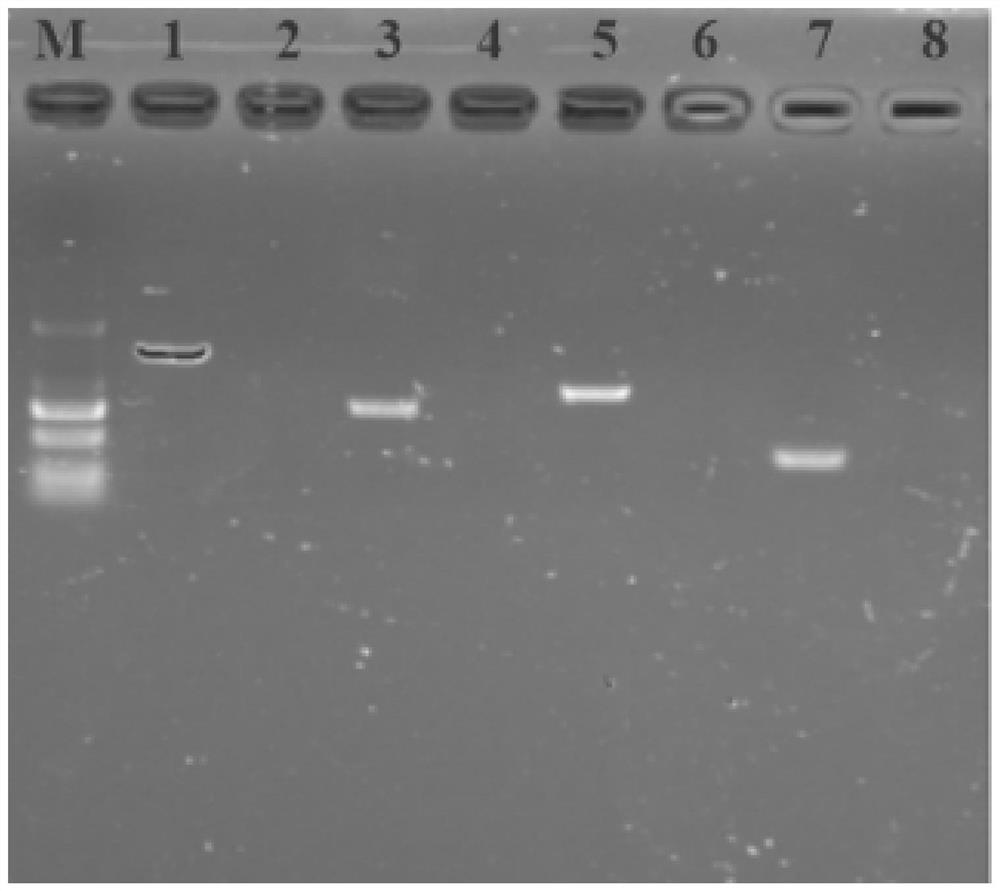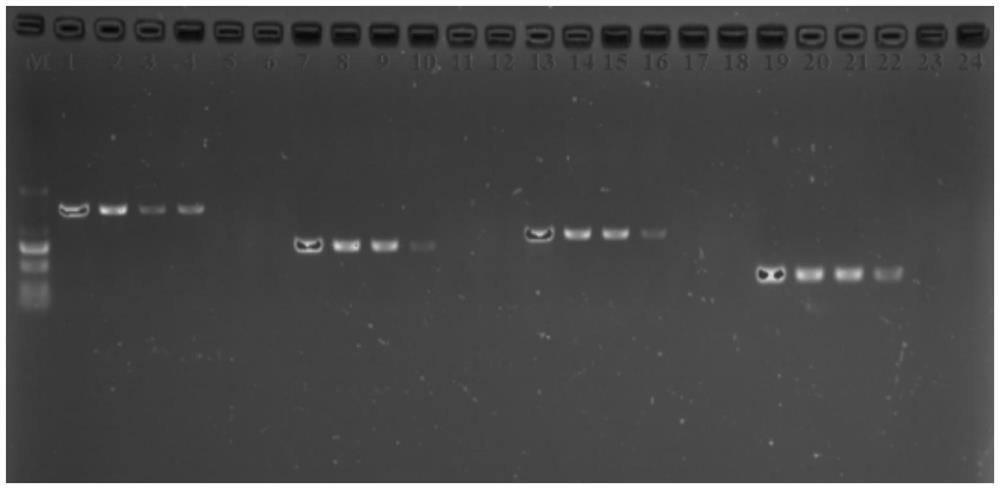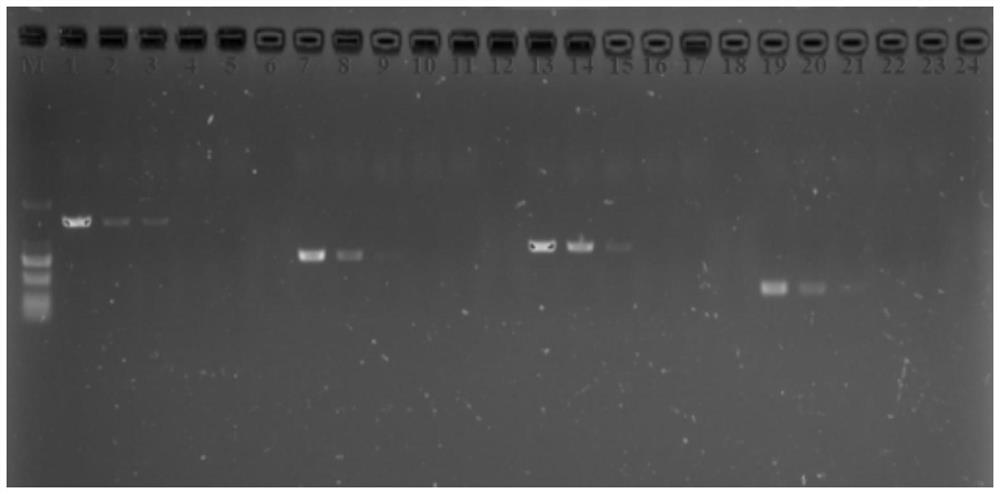System for detecting pear branch blight germs and construction method thereof
A construction method and technology of blight bacteria, applied in biochemical equipment and methods, microbial measurement/inspection, DNA/RNA fragments, etc., can solve problems such as missing and lack of detection methods, and achieve sensitive and reliable detection results, safe and efficient production The effect of sustainable development
- Summary
- Abstract
- Description
- Claims
- Application Information
AI Technical Summary
Problems solved by technology
Method used
Image
Examples
Embodiment 1
[0038] 1. Primer design for conventional PCR and multiplex PCR
[0039] The primers selected for the experiment in this example are PrimerE / PrimerF derived from the exopolysaccharide synthesis gene (amylovoran synthesis, ams) sequence on the chromosome of E. amylovora pathogen and two pairs of primers p29A / p29B and PEANT1 / PEANT2 derived from the pathogenic bacteria plasmid pEA29. The sequence, site, and size of the amplified bands of the three pairs of primers are shown in Table 1, the table of primers for the detection of Yali pollen amylovora pathogen. Primers were synthesized by Sangon Bioengineering (Shanghai) Co., Ltd.
[0040] Table 1
[0041]
[0042] 2. Culture of Erwinia amylovora
[0043] The prepared LB medium was steam sterilized at 121°C and 0.1MPa for 20 minutes, then poured into a plate on an ultra-clean workbench, and allowed to cool for later use. Take the preserved Erwinia amylovora strain out of the -20°C refrigerator, and after thawing, take a ring wi...
Embodiment 2
[0065] Embodiment 2, dual PCR system establishment and sensitivity detection
[0066] Double-PCR system: Double-PCR is to add two pairs of primers to a small PCR tube for PCR amplification, and produce two products of different sizes. ddH 2 O was replaced with the bacterial solution as a blank control, and 3 μL of the amplified product was detected by 1% agarose gel electrophoresis, stained with ethidium bromide, and observed under a fluorescent imaging system. The combinations are as follows: double PCR combination 1: PrimerE / PrimerF+p29A / p29B; double PCR combination 2: PrimerE / PrimerF+PEANT1 / PEANT2, as shown in Table 4, double PCR reaction system (25 μL).
[0067] Table 4
[0068]
[0069] Combination 1 reaction program: 94°C for 3min, 94°C for 30s, 52°C for 30s; 30 cycles, 72°C for 90s, 72°C for 5min
[0070] Combination 2 reaction program sets 2 annealing temperatures, namely 52°C and 54°C. Reaction program 1 is as follows: 94°C for 3 min, 94°C for 30 s, 52°C for 30 ...
Embodiment 3
[0080] Embodiment 3, routine PCR and double PCR method detect analog sample sensitivity
[0081] 1. Preparation of simulated samples: Take 10g of healthy Yali pollen and add it to 50ml of sterilized PBS solution, shake at 180rpm at a constant temperature, shake at room temperature for 1h, filter with sterilized filter paper in an ultra-clean workbench, take 7 sterilized 1.5ml centrifuge tubes, Add 1ml of filtrate to each centrifuge tube, centrifuge at 13000rpm for 10min, discard the supernatant, pour out the supernatant as much as possible, add 900μL sterilized water to suspend, and finally add 100μL of 7 concentration gradient bacterial suspensions to each centrifuge tube, and vortex Mix well and set aside.
[0082] Sensitivity detection of simulated samples by two PCR methods According to the reaction system established above, 2 μL of simulated samples of the first 5 gradient concentrations were taken for sensitivity detection, and ddH 2 O is blank control, detected by 1% a...
PUM
 Login to View More
Login to View More Abstract
Description
Claims
Application Information
 Login to View More
Login to View More - R&D
- Intellectual Property
- Life Sciences
- Materials
- Tech Scout
- Unparalleled Data Quality
- Higher Quality Content
- 60% Fewer Hallucinations
Browse by: Latest US Patents, China's latest patents, Technical Efficacy Thesaurus, Application Domain, Technology Topic, Popular Technical Reports.
© 2025 PatSnap. All rights reserved.Legal|Privacy policy|Modern Slavery Act Transparency Statement|Sitemap|About US| Contact US: help@patsnap.com



